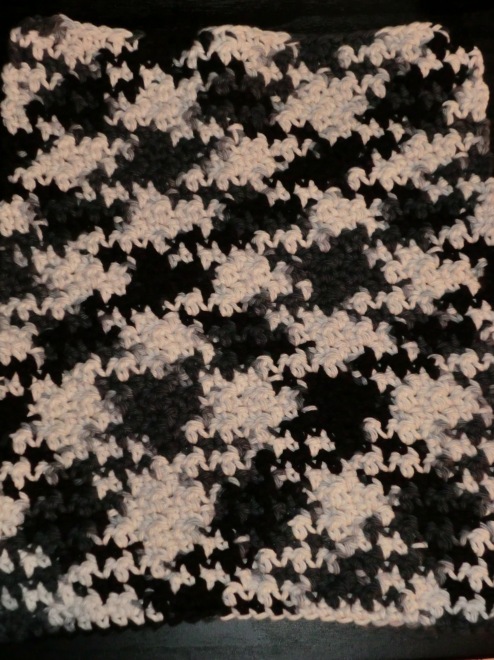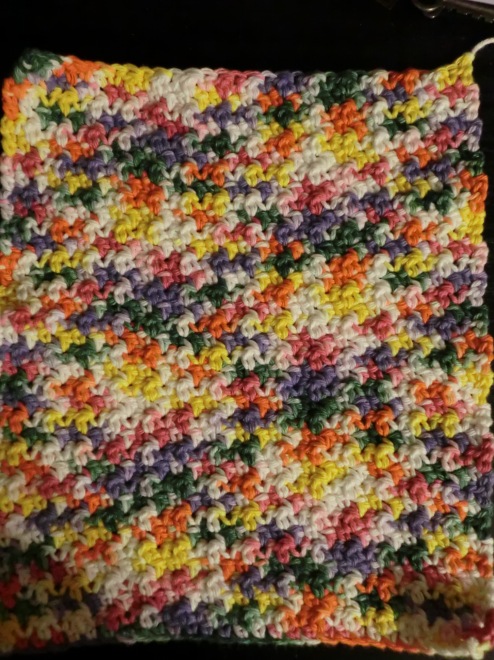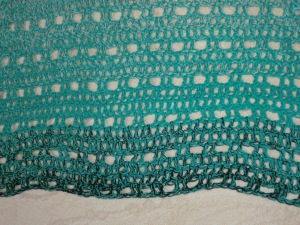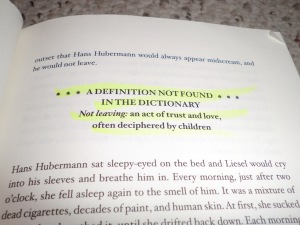Granny Squares: A Brief Rant
I often feel like crocheting is the red-headed stepchild to knitting. Most of the samples in any given yarn store are knitted. When I go to a yarn store and browse the pattern books, there are binders full of lovely knit patterns and one for crochet containing ugly, bulky sweaters and amigurumi. If I set my default pattern page on Ravelry to knitting and crochet, the highlighted patterns are inevitably both knitted.
I wonder if crochet (and the people who practice this art) aren’t in part responsible for the secondary treatment. It seems like every few days in the new patterns section of Ravelry, someone publishes a new granny square pattern. My beef with granny squares is this: every hooker, it seems, learned early on to make a basic 3-dc-cluster granny square, the style exemplified by afghans draped over backs of couches in the movies and rampant in any ’70s crochet publication. There is nothing original about them; sure, you might tweak beginning chain a bit or alter the number of stitches between clusters, but fundamentally, it is a granny square. Publishing a new basic granny square pattern is not an innovation.
Now, I recognize there is a lot you can do with a granny square, many different shapes and geometric designs within them, at least 99 of them, in fact, plus many more by independent designers. I am currently making a Latte Macchiato throw for my living room that features circle-in-a-square motifs. These add something new to the mix, and not all of them are even square. These are positive developments, something new to add, a way of updating a classic and keeping crochet fresh and original. There is something satisfying about a modular project where you can see the stack of motifs grow, validating your sense of accomplishment (see: hexipuff trend, Ravelry).
I’m not even saying it’s time to retire the granny square; some of my favorite projects to see are scrapbusting granny blankets, with their riots of colors (and no doubt a billion ends to work under). What I am saying is that the basic granny square has been around a long time. The world does not need to keep re-issuing of the same pattern again and again. Change it up a bit. Or better yet, let’s work to move crochet past the perception of granny squares and amigurumi.
Recent-ish reads, digest edition
A month-long posting drought isn’t the most auspicious start to a new blog. Hopefully it won’t happen again. Why the drought? Well, the end of a semester is always intense in academia with lots of papers and odd ends of assignments to grade. I decided to make it more interesting by moving in the midst of all that. In the long run, though, that move should yield more blogging material since I now have more time to both read and crochet. Yes, it turns out that days seem to have more hours in them when one doesn’t have a TV or wireless internet at home. It may be spartan, but my quality of life has gone up as a result. My recent reads list is testament to that:
Dry, Augusten Burroughs – OK, technically, I read this before the move but just didn’t get to blogging it. If anyone has read Burroughs’ previous memoir Running with Scissors, which tells of the utmost dysfunctional upbringing, it should be no surprise that this memoir traces his struggle with alcoholism. It’s got his signature dark humor, but more than anything, his humanity is what shines through. Readers can find something to identify with, whether it’s his attempts to make the right decisions or struggle to come to terms with difficult and painful feelings.
The Midwife, Gay Courter – This was the first book I read in the new place. I love a good work of historical fiction. I also love stories with strong yet believable female protagonists. Oh yes, and I also love immigrant stories of people making new lives for themselves in a relatively young America. This had everything, and once I got into the story, I could barely put it down as I followed protagonist Hannah Blau from an increasingly anti-semitic Russia to America where she struggled to hold her marriage together and was up against a medical profession bent on putting midwives out of business.
Franny and Zooey, J.D. Salinger – Several years ago, I read Catcher in the Rye for the first time. I chalked up my dislike of it to my being probably too old to be reading it for the first time (the best time likely being the teenage years), so I decided to give Salinger another try. Can’t say I particularly cared for this one either. I believe that he captured some of the listlessness of a post-WWII ennui. That said, I still found the characters self-absorbed and difficult to identify with or even like.
Bluebeard’s Egg and Other Stories, Margaret Atwood – The first book of Atwood’s I ever read was Oryx and Crake, which while a bit didactic was still an excellent read. That was quickly followed by reading The Handmaiden’s Tale, another powerful dystopian read. Usually two strong books is enough to indicate a favorite author. Not so in this case. Bluebeard’s Egg is one of several of Atwood’s books that I have since tried reading. Several stories are good (the title story, for one), and many of them deal with characters coming to terms with changes or cracks in the facades of their relationships, but as a whole, I would not go out of my way for this short story collection.
Working for the Devil, Lilith Saintcrow – This is the first novel of the Dante Valentine series, and wow, was it hard to put down. To be straightforward, this is not high literature. It is not deep or profound. But it tells a story so fast-paced and engaging with a strong heroine that I maaaaay have set aside my grading for an evening to devour it, which is the mark of great storytelling. I like a bit of urban fantasy with a strong, somewhat mouthy protagonist (a la Jim Butcher’s Dresden Files or to a lesser extent Laurell K. Hamilton’s Anita Blake series). This tale of a necromancer enlisted by Lucifer himself to chase down a lesser demon and given a demon familiar to aid in her quest was an intensely enjoyable bit of escapism.
Dead Man Rising, Lilith Saintcrow – After Working for the Devil, I promptly checked out the next few Dante Valentine books from the library, and this is the second. I approached this warily since sequels often disappoint, but this one didn’t. At times, Dante Valentine got a bit, well, emo, for lack of a better word, but given the circumstances, it was at least understandable if moderately irritating. However, did it also tell a fast-paced yarn that kept me up late and made an evening fly by rapidly? Oh yes.
The Better Part of Darkness, Kelly Gay – Ironically, I realized that this book had an endorsing blurb from Lilith Saintcrow on the cover. It’s yet another urban fantasy novel with a tough female protagonist (a single mother detective in this case). It’s set in Atlanta, a city that has become almost a portal for otherworldly beings, some creatures of light and goodness and the others much darker and more dangerous. It was also good escapism and I may follow up with the next book in what appears to be the start of a series, but it won’t break my heart if I don’t either.
That brings my current reading up to date. For a preview of coming attractions, here’s what’s on the current reading stack: Bram Stoker’s Dracula and Neil Gaiman’s Neverwhere.
Backwards
When she was teaching me to crochet, the advice my grandma gave was to “hold [my] hook like [I] would a pencil.” To this day, my hook sits neatly in my hand, the tension light, leaving my hand able to crochet for long periods of time without cramping.
Now I just need to learn how to hold my pencil like I do my hook…
Utilitarian crochet
I’ve only had energy for small things lately. Why? Because my work schedule just went hectic, and they’re instant gratification. I may know rationally that even a quarter of an ever-lengthening row of a shawl edge an evening will eventually add up, but try telling that to a tired brain. No sirree, I’ll go for the quick thrill, thankyouverymuch. On top of that, they’re usually stash-buster and practical sorts of things. Yes, it’s been a whole month at least since I bought any yarn (a statement that has the feel of an AA meeting confession). Everything made since then has been from stash yarn, odd skeins and scraps.
The other night, I decided to make a dishcloth. There is no more perfect a project for a mind that wants enough distraction to shut down the whirling thoughts but needs said distraction not to be too taxing. Oh, mind you, there are some fancy-pants dishcloths out there. Some are downright frilly things that I just can’t see plunging into a greasy pot or scrubbing down a counter. No, the dishcloths I’ve made are sturdy things that hold up for years after their colors have all run and become faded messes.
They don’t have to be pretty. Good thing for that. My latest effort has neat texturing, courtesy of the moss stitch. The colors of the ombre have pooled nicely too. But one color of the ombre, a beige, looks dirty, and I haven’t even used the cloth yet! It photographs OK, but the in-person color is uninspiring. As a result, I’ve dubbed my project the “Fugly Dishcloth” on my Ravelry project page:

A few days later, last night, I found another odd skein in need of a project, so I made a second dishcloth with the pattern. The color combo is called “gumdrop,” and I think it must have fallen into my hands as a gift. Doesn’t seem like something I’d buy for myself! I liked the overall look of this better but wished the colors had pooled a little differently, so I’ve dubbed it “Not-so-fugly Dishcloth” on its Ravelry page:

Lest it sounds like I’m denigrating my own work in an effort to gain compliments, I’m not. Consider my tone one of fondness. These may not be among the more glamorous or exciting of my projects, but they’ll be used and loved.
Red Sky at Morning
As a patron of used book stores and library book sales, I tend to get greedy in my book buying habits. A twenty-dollar book is easy to resist. Twenty one-dollar books is much harder. The result is two bookcases overflowing with books, two thirds of which I’ve never read. Slowly, slowly, I make my way around to reading them.
The most recent of these yet-unread books that I finally got around to reading was Richard Bradford’s Red Sky at Morning. A blurb on the back hailed it as a humorous coming-of-age story, and that’s an accurate depiction.
Seventeen-year-old Josh Arnold was born and raised in Mobile, Alabama, but when his father joins the Navy during WWII, Josh and his mother go to live in Sagrado, New Mexico, where they had previously only spent summers. Josh settles quickly into the routine, befriending Steenie and Marcia, making any enemy of bully Chango, and befriending local artist Romeo and his revolving series of mistresses/muses. His mother, however, struggles with the adjustment in large part due to her Southern-instilled notions of propriety and insistence on only spending time with a select few of the “proper” sorts of people. Her attitudes are racist and class-ist, but Bradford never hits the reader over the head with Just How Bad this is; she is simply a character the product of one upbringing who is abruptly transferred into a very different environment, finding herself unable to adapt.
The characterizations are well-done and the dynamics as well. Some of the best passages are comprised of the banter between Steenie, Marcia, and Josh, as they heckle and bounce ideas off of each other. For anyone who’s ever had a tight core of smart-alecky friends, the dialogue rings true.
If I have one criticism, it is that the ending feels rushed. An event in the next-to-last chapter quickly changes the leisurely pace at which the tale had been unwinding to an abrupt end that, while realistic, just felt jarring by comparison. This is a small criticism of a book that I otherwise enjoyed.
Currently on the hook
I’ve admitted previously that I frequently have multiple crochet projects going at any given time. If I were to stop and compile a complete list of projects pending, I’d get overwhelmed and also wonder where to draw the line: “Wait, OK, so that black chenille shawl is currently technically in progress, but I’ve not touched it in six months–does that still count?!”
No, best not to think too hard about it. I’ll talk about one of my projects pending.
Late last year, amidst a holiday season that was ridiculously stressful, I joined a swap in Ravelry’s Odd Duck Swaps group. When I signed up for the winter sanity swap, I had no inkling how welcome a diversion it would be. The idea of the swap was to put together a kit for a project and some goodies to help your spoilee get through the stress of the season. Granted, I didn’t get to working on the project itself for a little while longer, but I finally started it in February.
My spoiler gave me all the makings for Eva’s Shawl. She even went all out and bought me the most gorgeous carved wood hook to crochet with and a skull and knitting needle cross-bones project bag to tote it in. The yarn was from Wolle’s Yarn Creations in seafoam green, reminiscent of one of my favorite colors, teal. It’s aaaaaalmost done, my shawl, and with the weather warming up (sort of), I think the light weight of the shawl will be perfect.
Anyway, enough blathering. Here’s where it stands right now, about 75% done or so:

Here’s a close-up showing the gradual color shifts:

And lastly because they’re both so pretty, my yarn and hook:

The Book Thief
For a while, I’d heard rave reviews about Markus Zusak’s The Book Thief, so I flagged it as something to keep in mind as I combed used book stores. A couple months ago, I found it. Recently, during a spring break that I primarily spent huddled up in bed and miserable with the flu, I read it.
It is a dark and beautiful book.
Narrated by Death, The Book Thief tells the story of Liesel, a girl sent to live with German foster parents in the lead-up to WWII. She is the titular book thief, beginning with the grave digger’s manual she snags at her little brother’s funeral. She can’t read the book initially, but with the help of her loving and constant foster father, she learns, and over the course of the novel, indeed steals other books. Only a book at a time and frequently when she’s the most agitated by life.
The cast of characters of strong. Hans Huberman, the father, is loving and constant. Rosa Huberman, his wife, is a sharp-tongued woman whose constant verbal barrage masks her more caring personality. In time, they end up sheltering a Jew named Max Vandenburg, a man with “hair like feathers” who becomes good friends with the girl and even writes her some stories of his own on the painted-over pages of Mein Kampf. Their friendship is I think the most touching in the book since they are both traumatized by experiences and find comfort in sharing their nightmares with each other. Liesel’s best friend and accomplice to mischief is Rudy Steiner, a boy with lemon-colored hair who always asks her for a kiss. The primary source for Liesel’s later book thefts is the mayor’s wife, a shadowy, depressed woman who leaves her library accessible to the girl, tacitly encouraging the thefts and later recommending that the girl write her own story.
We all know the tragic consequences of the German Holocaust, and narrator Death does mention how busy the events keep him. But Zusak doesn’t dwell on the large-scale casualties, with the result being a more human–and devastating–look at personal loss during war. While the march of Jews through town is heartbreaking, so too are the results of a bombing campaign near the end of the book. As tragic as the losses are, the survivors’ emotions are more so. It’s a no-win situation, which is written well.
That said, the book also has very beautiful moments. As mentioned, the relationship between Leisel and her accordian-playing Papa is touching. His having a fourth-grade reading level doesn’t stop him from doing what he can to help the girl learn to read after she is awakened by nightmares is touching and indeed is a gift that serves her well throughout the novel. As many books are, The Book Thief is also an homage to the power of reading to transport people from dreary circumstances. This is illustrated simply and beautifully when Liesel reads aloud to everybody in the shelter as they wait for a bombing campaign to end. It’s telling that each time they have to go wait out a bombing, Liesel grabs her books to take with her–a bittersweet detail that is sure to make most bookworms smile a little in identification.
Death’s–and the book’s–final words are: “I am haunted by humans.” Fitting words for a haunting book.
“Not leaving”
A touching excerpt from my current reading, Markus Zusak’s The Book Thief.
Stages
It seems like any crochet project has several distinct stages. Your mileage may vary, but here are mine:
1. Stash (a.k.a. raw potential): Of all the stages, this one varies the most wildly in length. In stash stage, anything is possible. That skein that you keep wandering by and rubbing against your cheek can be absolutely anything you put your hook to. It can go from scarf to cowl to wristwarmers with just a bit of imagination. And it’s pretty. And soft. You can’t keep your hands off that skein, and if it had hands, you’re pretty sure it’d be all over you too. Other people are probably a little uncomfortable watching the two of you.
2. Planning (a.k.a. potential, part two): Sometimes this overlaps with stash stage, particularly when one is disciplined enough to buy yarn with specific projects in mind. Other times, eh, it takes a little more time. One thing is certain: once you have the pattern, you know the inevitable conclusion: you will see it through to completion, oh yes, whether it knows it or not. I mean, come on, you’ve got the hook picked out and everything.
3. Beginning of project (a.k.a. the “ooh shiny” stage): This is the honeymoon period of a crochet project. Everything is amazing. The yarn? Amazing. The pattern? Amazing. The project just beginning to take shape and emerge as a beautiful project butterfly from a yarn cocoon? A veritable miracle. At this stage, people tend to ask questions like “Oh, what are you making this time?” And like any blushing newlywed, it’s the opportunity we hookers have been waiting for: “This is my new project. We’ve been together for two days, and I couldn’t be happier. I never believed in happily ever after until I started the base chain, and then, oh god, it was like destiny. I don’t know what I did with myself before he it came along.”
4. Reality (a.k.a. grumblings of discontent): Just as the newlywed realizes that her new dreamboat leaves his toenail clippings on the floor and the dishes a mere two feet away from the dishwasher instead of finishing the job, so too does the hooker realize that the formerly shiny project wasn’t actually quite so shiny. A frustrating row pops up in the instructions, or the yarn has unwelcome knots in it. Maybe the pattern repeat isn’t quite committing itself to memory as easily as one hopes. At least those irritations show there’s still an emotional attachment. Better that than…
5. Tedium (a.k.a. the “that new shiny project is looking awfully appealing” stage): “Oh,” you say to your project upon reuniting after a long day at work, “it’s just you.” Nothing is new, endearing, or even surprising anymore. It’s the seven-year-itch of the crafting relationship. You can go one of two routes from here:
6a. Grim determination (a.k.a. the “we’re stuck until the project grows up, so let’s just get through this” stage): At this point, you realize that the end is in sight if you can just make yourself do a set number of rows each night until it’s done. This may not be the most thrilling course, but as the end gets closer, some of the old excitement is rekindled. You remember why you fell in love in the first place and look forward to growing old with your completed project or giving it to someone you care about to grow old with. This is the logical, straightforward, pragmatic approach. However, there’s another way.
6b. Distraction (a.k.a. the “harmless little fling”): “Hello there,” you tell that skein of sock yarn that’s been making eyes at you from the yarn bin. “How you doin’?” You look over your shoulder at the once-so-promising project and sigh wistfully at what could have been. You may even feel guilty. But right over there is a shiny new project waiting, and if you’re honest with yourself, you and your little fling were already skipping merrily through steps 1 and 2 long before this point. You already had the hook picked out, didn’t you, scoundrel? And besides, it’s not so bad, honest; you’ll go back to the other project originally.
Once a hooker reaches stage 6b, anything goes. Monogamous crocheting becomes a thing of the past. Is there a way back from such debauchery? If I ever find out, I’ll let you know.
Legacy
Every hooker remembers her (or his!) first time. It’s rarely what you would call “pleasurable,” but that comes later.
When I was 11, I was being homeschooled for the first time, and I believe my grandma was newly retired and had a lot of time on her hands. I’d seen her plenty of times with knitting and crocheting in her hands, fingers flying as a garment or blanket practically materialized right then and there.
Was I interested in learning how? Oh yes. It would be cool to learn how to do that. To make something, like the blankets I had from her or the owl vest from when I was a wee thing to the mittens and scarf I used to bundle up in during the winter–how awesome.
So during quiet afternoons that were partly comprised of math lessons and watching old Columbo episodes, she taught me to crochet. Learning to make a basic chain was simple and fun; indeed, like my younger sister a few years later, I probably spent a chunk of time making chains that were yards long, much too long to be of any practical use.
The next step was a pot holder in single crochet, worked around and around until it was big enough to sew the sides together. That was a valuable lesson in stitch count. Specifically, I learned that adding an extra stitch or two makes the “fabric” of the piece bulge, and dropping stitches draws it in. The finished product was lumpy and uneven, and I had yet to master tension: my stitches were very tight. I gave that potholder as a gift to someone who later moved away and was never heard from again, and I wonder in retrospect what she thought of that lumpy little potholder, if she appreciated it as the culmination of eleven-year-old pride in the accomplishment of a new skill. I’ll never know; at any rate, I’ve become a lot more discriminating in who I give my handmade wares to.
One potholder became two and so on, and I learned new stitches and new combinations. My projects became more sophisticated, and any time I had a question, I knew I could go to Grandma to answer any question I might have.
Years continued to pass, and my projects grew more daring–a cloak, a sweater, scarves with novelty yarns… Something was shifting though; at times, the questions I’d bring my grandma stumped her. “Reverse single crochet? Never heard of it.” Other times, if I’d show her a problematic part of a project, she’d be unable to see it clearly enough to tell me what was wrong. Her own crocheting slowed down too. Between low vision and two rounds of chemotherapy that left her with neuropathy in her hands, her once-prolific output dwindled to nothing. She could at least crochet vicariously through me, stroking the increasingly fancy yarns I started buying, marveling at the crazy antics of various eyelash yarns, wondering at all the colors and textures and fibers that had exploded into the world since she first picked up a hook herself.
And that too ended with her death late last year. I’m on my own now, and I miss showing her what I have on my hook at any given time. It’s human nature, I think, to cling to the memories of loved ones, and I have a lot of lovely memories. But I have tangible old ones, too, in the form of blankets she’d made me over the years that are still as warm as they ever were. More dynamically yet, every stitch I crochet, every project I complete, is a realization of the legacy she left me: the gift of taking yarn and with some deft twists of hand and hook, creating something beautiful that will hopefully become someone else’s beloved keepsake.
I think she’d be proud.
